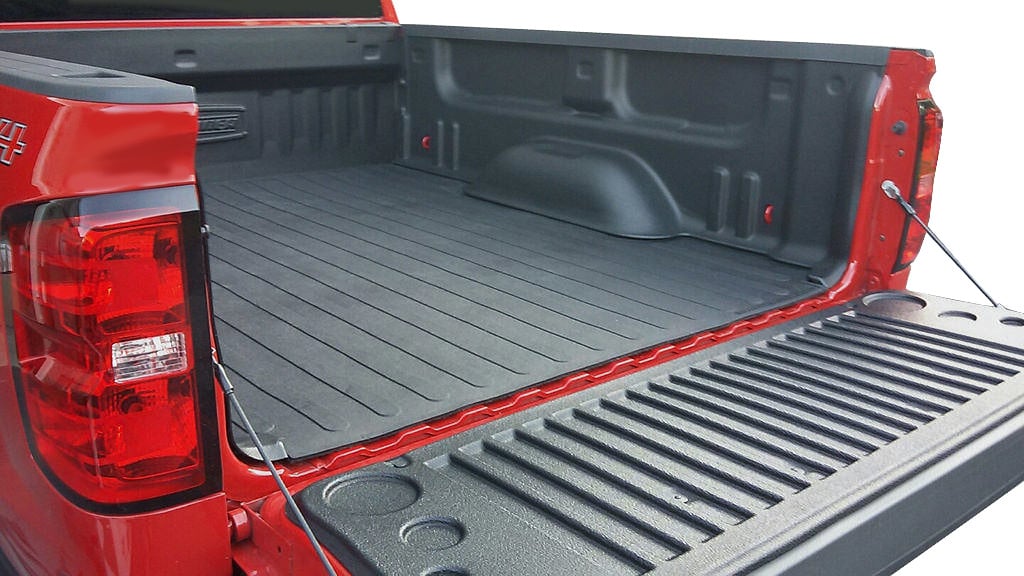Truck bedliners are products that have two purposes. The first, and most obvious, is that they shield a truck bed from physical damage. The second is that they can create a skid-resistant surface that helps cargo to stay in place during transport.

There are two broad classifications of bedliners on the market today: “Drop-in” and “Spray-on”. “Drop-in” bedliners are large, preformed plastic inserts that are installed in the back of pickup trucks. They are usually custom made for specific models and thus fit nicely. “Spray-on” bedliners are, as you might expect, sprayed onto the bed floor and inner bed walls. These can be applied by professionals however DIY products are available.
The History of Bedliners
Protecting the bed of trucks has been around since the beginning of the breed (1910s.) Back then and for several decades afterwards, bedliners were handmade and mostly consisted of just wooden planks. As soon as plywood became available, it became common for truck owners to cut out a custom profile of their truck bed in plywood and bolt it in. Others took large rubber mat material and custom fitted it to their truck beds. There were, no doubt, other constructions.
In 1983, Penda Corporation developed the first drop-in bedliners. Not long afterwords, Morgan Evans founded Rhinolinings in Johannesburg, South Africa to develop a urethane-based protective spray coating that was targeted at the truck bed marketplace. As they say, the rest is history.
About Drop-in Bedliners
According to Mr. Ed of Phoenix, a local automotive financing firm in Phoenix, AZ, the drop-in, or plastic bedliners, are the most commonly found type of bedliner, at least right now. Drop-ins can usually be installed rather quickly with no major modification made to the bed of the truck. Typically made of a polyethylene composite, drop-ins are a rigid structure formed to the contours of a specific vehicle model. They are available preinstalled by most new car dealers.
Spray-on Bedliners
Spray-on bedliners are a little more recent and have become very popular. Since they are applied directly to the surfaces of a truck bed, they always “fit perfectly” and cannot trap moisture like the drop-in types are known to do. To get your truck outfitted, you can elect to have a professional bedliner company spray your truck bed with their own proprietary product, or you can buy a multitude of DIY spray-on products and do it yourself.
Chemical Details
Most spray-on bedliners are either 100% polyurea or 100% polyurethane, or a hybrid of both. Pure polyurea coatings are harder than polyurethane and have a high tensile strength that resists abrasion and tearing. The downside is that they are not very flexible. In fact, some polyurea coatings have been applied to military and private security vehicles for blast mitigation. Pure polyurethane coatings, on the other hand, are usually more flexible and softer than polyurea coatings.
But wait there’s more. There are also two chemical types of polyurethane/polyurea coatings to know about. The first is “Aromatic.” Aromatic is used to describe the chemical shape of the polyurethane compound with the shape of the molecules being in a ring. Aromatic compounds are used in polyurethane foams, elastomers, adhesives and coatings. Aromatics offer an extremely fast cure time and are the favorite of professional installers.
The second, “Aliphatic,” is also a term used to describe the shape of the polyurethane compound with the shape of molecules being either straight or branched. They are better option for colors because aliphatics are more stable over time in ultraviolet light but compared to aromatics. It should be noted that aliphatics have a slower cure time than aromatics and because they are derived from pure polyurethane, aliphatic formulations typically cost some 35% to 45% more than aromatic ones.
Application Details
You have two choices when it comes to getting your truck bed coated – professionally or DIY. If you elect to go the professional route, you will spend some money but you will a trained applicator who has the experience to deliver a smooth, even surface. Professionals also extensively sand the truck bed with power tools prior to spraying so the longevity of the coating should be excellent.
The alternative is go the DIY route. If you elect to do this yourself, there are many spray-on products available and quite a few roll-on. Some DIYers find the roll-on product is the easiest to apply and obtain a nice, uniform coating with.
By the way, bedliner coatings can be applied from 1/16 inch to 2 inches, depending on the application. Thinner coatings may cost less, but can chip and crack easier. Thicker coatings may affect the shape of the truck bed but will be more rugged than thinner ones. One manufacturer suggests the optimum coating thickness is 1/4 inch on the bed and wheel wells and 1/8 inch on the sides.
Which Brands to Buy
The bedliner industry has created confusion with regard to all the polyurethane and polyurea formulations. Each company boasts of its superior durability and ease of application. The reality is that they are all reasonably similar, barring low-quality inexpensive products. As we discussed, Polyureas and polyurethanes have differences chemically, but actually act similarly in many applications. For the purpose of commercial bedliner applications, the big difference is in the application process and the level of isocyanates and VOCs released. This is an important aspect of the bedliner industry, as the presence of VOCs and isocyanates prevents the application of spray bedliners in many states. For the DIY market, many products are water-based so levels of isocyanates and VOCs are irrelevant.
Other Applications
Spray-on coatings can be used for more than just truck bedliners. They also can be used to protect fenders, bumpers, floor boards, roll bars and even trim. In fact, whole vehicles have been coated. And, of course, you have commercial applications such commercial transport, heavy construction, farm equipment, boats and other equipment.
